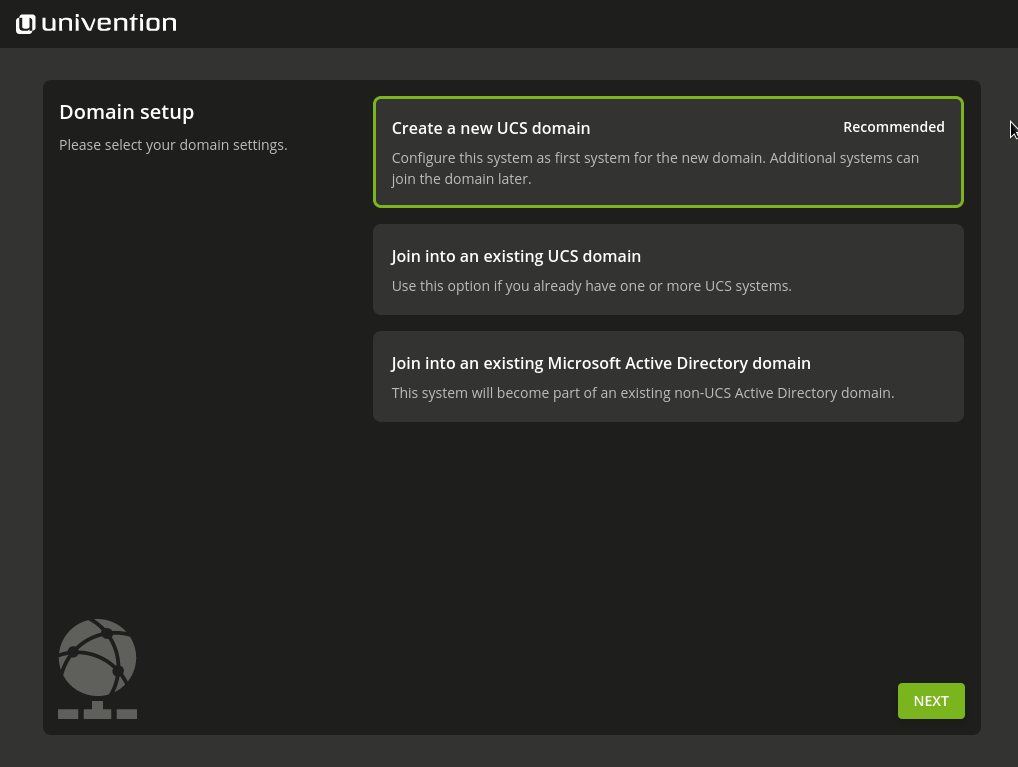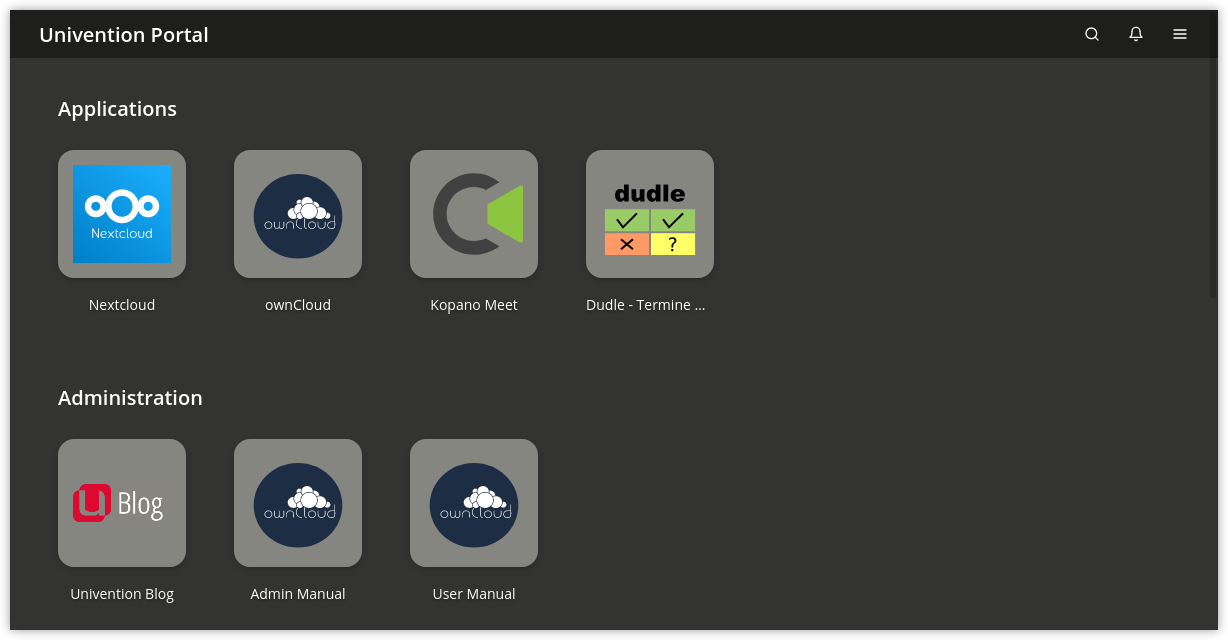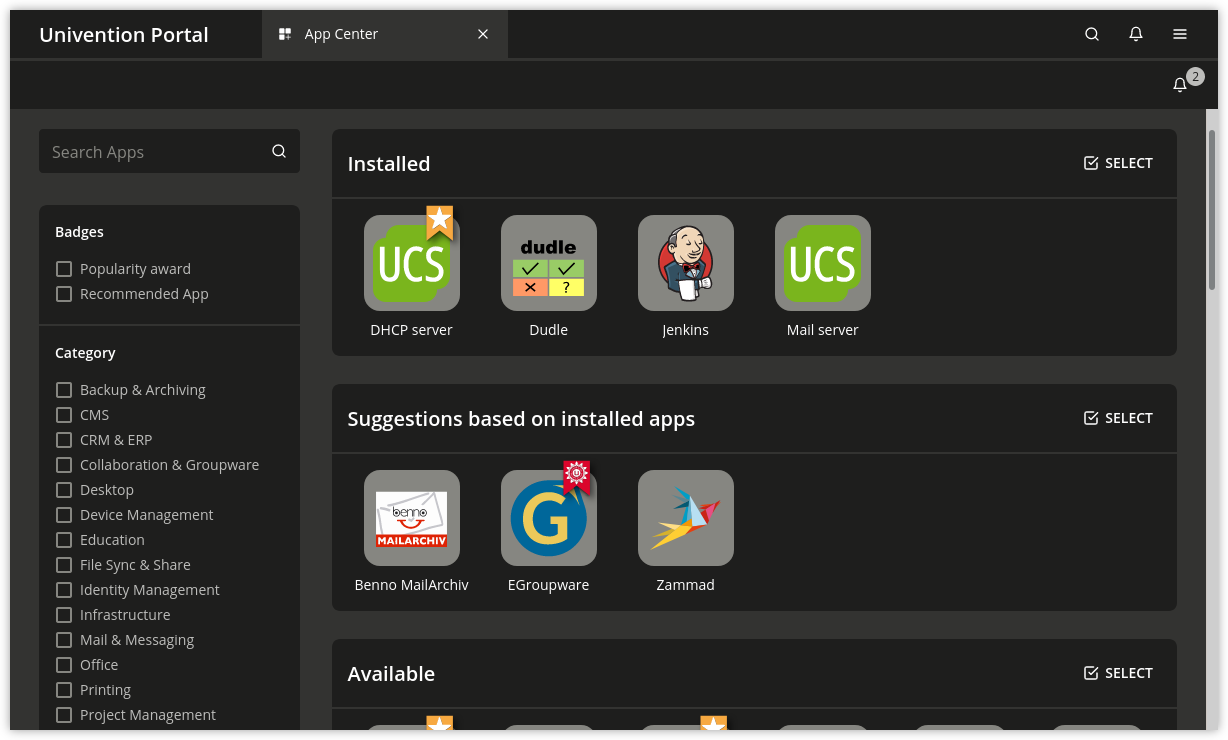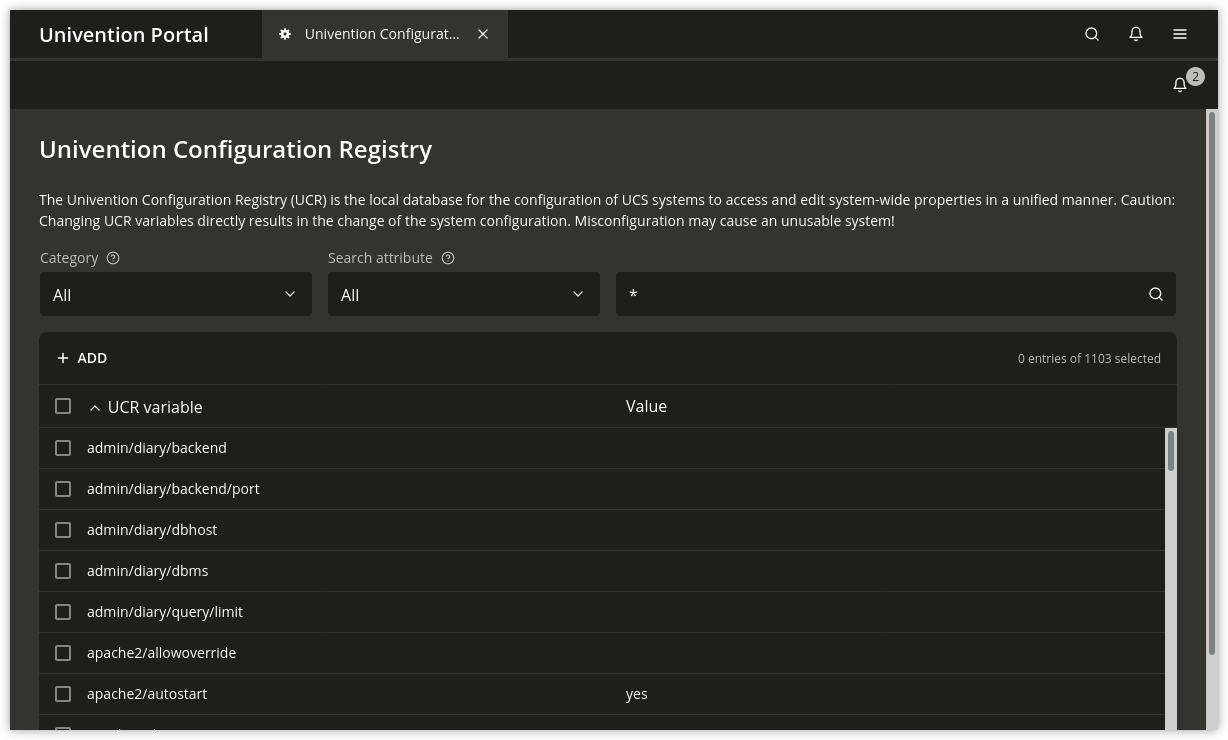1. Introduction#
Univention Corporate Server (UCS) is a server operating system based on Debian GNU/Linux with integrated management system for the central administration of servers, services, clients, desktops and users.
This quickstart guide offers a short introduction on how to get started with UCS. Several features of UCS are only mentioned briefly with a reference to further documentation. The documentation on UCS is available at https://docs.software-univention.de/.
The installation DVD can be downloaded from the Univention website at https://www.univention.com/downloads/download-ucs. The installation DVD is only available for the host architecture amd64 (64-bit). It has support for the Unified Extensible Firmware Interface-Standard (UEFI) including SecureBoot.
Alternatively preinstalled images for VMware and VirtualBox can be used from the same download page.
The system requirements vary considerably depending on the intended purpose and the number of users. The minimum requirements for the installation are 1 GB memory and 8 GB hard drive space.
2. Installation#
The installation is performed via a menu-driven installer and can be used both interactively and completely profile-based, see the Extended installation documentation.
The system language, keyboard layout and time zone can be selected in accordance with local requirements.
A valid network configuration should be set during the installation. If, for example, a gateway and a name server are specified, but the name server cannot be reached, this may result in unnecessary timeouts. In these cases, it makes more sense not to specify a gateway. The network configuration can be employed using DHCP. If there is already a name server available in the local network, it should be used. If additional UCS systems are installed in the domain at a later point in time, the Primary Directory Node and any Backup Directory Node systems should be entered as name servers.

Fig. 2.1 Selecting the domain setup#
During installation, the system can be used for various purposes which can only be configured at this point in the setup process.
The system is to be the first system in a new UCS domain and it is implicitly configured with the system role Primary Directory Node.
The system can be joined into an existing Active Directory domain. Select this option if UCS should not create a new domain. UCS then takes on the role of an Active Directory member server.
All other systems are joining the UCS domain when they are installed.
An overview of the other different system roles can be found in UCS Manual - System roles.
With UCS and the Active Directory Takeover app an existing Active Directory domain can be migrated completely to UCS. For information on how to set up the UCS system for this scenario, see UCS Manual - Migrating an Active Directory domain to UCS using Univention AD Takeover.
In the subsequent course of the installation, the fully qualified host
name, under which the computer should be accessible in the network, is
entered for a Primary Directory Node. A local name should also be used as the
domain name in this case, e.g. company.intranet. (If the system is used
as a mail server, for example, the mail domains can be used
independently of the domain names). For example, to commission the
mailserver host system in the company.intranet DNS domain,
mailserver.company.intranet should be entered as the fully qualified
host name. The LDAP base is suggested based on the
fully qualified host name and only needs to be adjusted in exceptional
cases. For all other systems roles it is normally sufficient to enter
the host name only. The domain name will we fetched from the
Primary Directory Node when the domain is joined. The root password must be at
least eight characters long and is also set as the password for the user
Administrator during the installation of the
first UCS system (Primary Directory Node).
An auto-partitioning feature can be used during the installation which creates an LVM volume group on the first hard drive by default.
The installed software components can be adapted later at any time and subsequently installed from the Univention App Center.
After confirming the configuration settings the installation is initiated. Once completed, the system must be restarted. The further configuration is made using the Univention Management Console (UMC). This is described in more detail in the following chapter.
3. UCS web interface#
The web interface of an installed UCS system is directly available via its IP
address (https://server_ip or http://server_ip, HTTPS is
recommended). By default, a portal page is configured on the
Primary Directory Node where all applications are listed that are installed in the
domain. For all other system roles, the start site consists of an
overview of all locally installed applications. (View as well as the
partitioning of entries can be customized in a very flexible manner, see also
UCS manual - Portal page as central view on the UCS domain.)

Fig. 3.1 Illustration of the portal page on the Primary Directory Node with all domain wide available applications#
On each start site of a UCS system, there is an entry System and
domain settings in the section Administration (or System
settings, respectively) that points to the Univention Management Console (UMC) of the
local system. Univention Management Console is the central tool for web-based administration of
a UCS domain. There are different modules available on the UCS system
depending on the installation and system role selected. The login to
Univention Management Console is performed as user Administrator with the password specified
for the user root during the installation.
For administrating UCS, the LDAP directory is the central component of a UCS domain. In the LDAP, domain wide information such as the users, groups and computer accounts is saved. Depending on the settings, this information is replicated to the other Directory Nodes in the domain either completely or selectively. The UMC modules which edit the LDAP directory directly can be accessed only on the Primary Directory Node via Univention Management Console. Furthermore, they can also be controlled using the command line interface Univention Directory Manager, see UCS manual - Command line interface of domain management (Univention Directory Manager).

Fig. 3.2 Modules in the UMC#
4. UCS updates / Installing additional software#
UCS updates can be installed in the UMC module Software update.
Additional software, like for example the Active Directory Connection, can be installed using the Univention App Center in the Univention Management Console:
Additional UCS software can be installed/removed using the category UCS components.
Third-party software (e.g. various groupware solutions) and UCS-compatible add-on products (e.g. UCS@school for school deployment can also be installed through the App Center.

Fig. 4.1 Subsequent installation of UCS components#
5. Configuration management using Univention Configuration Registry#
Univention Configuration Registry is the central tool for managing the local system configuration of a UCS system. Settings are specified in a consistent format, the so-called Univention Configuration Registry variables. These variables are used to generate the configuration files used effectively by the services/programs. Direct editing of the configuration files is only needed in exceptional cases.
Univention Configuration Registry variables are managed via the Univention Management Console module Univention Configuration Registry. Configuration files are automatically updated when the UCR variables registered on them are changed.

Fig. 5.1 Managing Univention Configuration Registry variables#
6. Clients#
In addition to the UCS systems, a UCS domain can also integrate different clients. The following clients are supported:
Microsoft Windows clients can join an AD-compatible Windows domain provided by the Active Directory compatible domain controller component (implemented using the software Samba). Further information on setting up Samba and the domain join of Windows clients can be found in UCS Manual - Windows domain joins.
macOS systems are also integrated via a Samba-based, AD-compatible Windows domain. Further information on setting up Samba and the domain join can be found in UCS Manual - Mac OS X domain joins.
Ubuntu systems (see Integration of Ubuntu clients into a UCS domain) and other Linux distributions like Debian, SUSE or Red Hat can also be integrated into the domain, see Integration of Linux/Unix systems into a UCS domain.
7. Further expansion of the domain#
This quickstart guide only provides an entry into UCS. UCS is very scalable, additional services can simply be installed on additional systems. This domain join is described in UCS Manual - How UCS systems join domains.
UCS offers various additional services which are covered by the UCS license and which can be integrated at a later point in time:
Single-sign-on with web services using a SAML identity provider, see UCS manual - SAML identity provider.
UCS manual - Web proxy for caching and policy management / virus scan.
Hybrid cloud setups
8. Further information#
Univention Corporate Server provides comprehensive documentation:
The primary source of information on UCS is the UCS Manual for users and administrators.
Further documentation for advanced scenarios can be found in the extended documentation. The various documents are linked at https://docs.software-univention.de/.
Answers to frequently asked questions can be found in the support and knowledge database (SDB).
Questions on UCS can be asked at Univention Help.